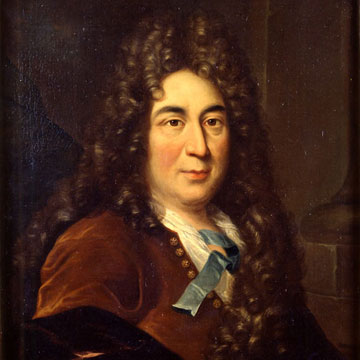 Charles Perrault,
Charles Perrault, author of Little Red Riding Hood, Sleeping Beauty and Cinderella was born 388 years ago in Paris. It was 1628, and he was a lawyer before turning his hand to the written word.
Perrault was born into a wealthy family, studied law and enjoyed a successful career as a civil servant.
But after losing his job aged 67, he decided to dedicate time to his children and penned a book called Histoires ou Contes du Temps passé (Tales and Stories of the Past With Morals), with the famous subtitle "Tales of Mother Goose".
While the Brothers Grimm are widely credited with creating the fairy tale as we know it, Perrault actually wrote Le Petit Chaperon rouge, La Belle au bois dormant and Cendrillon a full 200 years before.
In 1695, aged 67, he wrote Tales and Stories of the Past with Morals, a series of moral tales designed to prompt the reader to reflect on the dilemmas presented to the protagonist, which were well-known from folklore even then.
The volume contained the story now known as Mother Goose, alongside perrenially recognised titles such as Puss in Boots, Blue Beard and Cinderella, and less famous stories Ricky of the Tuft and Little Thumb.
The book was enormously successful, and was eventually translated into English in 1729 by Robert Samber.
However, readers may be shocked to discover that Perrault's original tales have lost much of their grizzly detail today. His version of Little Red Riding Hood, for example, made it more explicitly obvious that the 'wolf' is a man intent on preying on young girls who wander alone in woods.
"From this story one learns that children, especially young lasses, pretty, courteous and well-bred, do very wrong to listen to strangers, And it is not an unheard thing if the Wolf is thereby provided with his dinner," he wrote.
"I say Wolf, for all wolves are not of the same sort; there is one kind with an amenable disposition – neither noisy, nor hateful, nor angry, but tame, obliging and gentle, following the young maids in the streets, even into their homes. Alas! Who does not know that these gentle wolves are of all such creatures the most dangerous!"
Stories or Tales from Times Past
- La belle au bois dormant (The Sleeping Beauty in the Wood)
- Le petit chaperon rouge (Little Red Riding Hood)
- La Barbe bleüe (Blue Beard)
- Le Maistre Chat, ou le Chat Botté (The Master Cat; or, Puss in Boots)
- Les Fées (The Fairies)
- Cendrillon, ou la petite pantoufle de verre (Cinderella; or, The Little Glass Slipper)
- Riquet à la Houppe (Ricky of the Tuft)
- Le petit Pouçet (Little Thumb)
The version of Sleeping Beauty we know now is a combination of a tale by Perrault (which in turn was based on older stories dating back to the 14th century) and the Grimm Brothers's Briar Rose, which was an oral version of Perrault's.
Confusing? It can be. Disney's 1959 film sweeps away the darker elements of the Sleeping Beauty stories – and they can be very dark – in favour of Princess Aurora, her three fairy godmothers, and the vengeful fairy Maleficent, who uses an enchanted spindle to put the princess into a deep sleep.
Yet another reason to avoid doing your own sewing.
In 2011, a version of Sleeping Beauty, directed by Julia Leigh, harked back to Perrault's original tale. Emily Browning played a cash-strapped student who takes a job at a brothel.
She strips naked and is drugged into a stupor, before equally naked old men pay to climb into bed with her.
The story of Maleficent was turned into a film in 2014 with Angelina Jolie in the title role. The character's wickedness is limited to a fit of rage at Princess Aurora's christening, for which she spends much of this film trying to make amends.
Only five years after the Lumière brothers recorded what is widely considered as the first film ever made, French director Georges Méliès made the first cinematic contribution to the Cinderella dynasty in 1899.
Based on Perrault’s story it contains all of the classic plot points: a fairy godmother who turns Cinderella's rags into a beautiful dress and a pumpkin into a coach, the tick of time, and a charming Prince. At the time, the six-minute film was considered a complete failure – not so anymore.
Disney's latest film of Cinderella, directed by Kenneth Branagh, came out in cinemas last year.
In this version of the fairy tale, Lily James and Richard Madden come together over a lost slipper, while Cate Blanchett plays a perfectly evil Lady Tremaine.
Branagh and screenwriter Chris Weitz stick with almost doggedly traditionalist reverence to Disney’s 1950 animated version, with just a few tactful innovations here and there.
In 1901, Méliès made a film based on Perrault's Bluebeard, the story of a maniacal aristocrat with a penchant for slaying his young wives and the attempts of one wife to avoid the fate of her predecessors.
In 2010, the tale was adapted for film by French novelist and director Catherine Breillat, with Dominique Thomas as Barbe Bleue (Bluebeard).
Since the first Google Doodle in 1998, more than 2,000 have been created for Google homepages around the world. # Source: The Telegraph
 Charles Perrault, author of Little Red Riding Hood, Sleeping Beauty and Cinderella was born 388 years ago in Paris. It was 1628, and he was a lawyer before turning his hand to the written word.
Charles Perrault, author of Little Red Riding Hood, Sleeping Beauty and Cinderella was born 388 years ago in Paris. It was 1628, and he was a lawyer before turning his hand to the written word. 